Powering your household with a solar microgrid makes it more resilient, reliable, and sustainable because you’re using a renewable source to produce your own electricity 24/7. But are people also saving money on energy bills by getting solar microgrids?
Yes. And many more of us should be.
Millions of people in the US and billions worldwide could cut costs by powering their homes and businesses with solar microgrids.
In most places, it’s cheaper to produce electricity by collecting sunlight instead of digging up and burning fossil fuels. That’s why we keep seeing more people cover their roofs with solar panels.
And recently, storing large amounts of energy in lithium-ion batteries became affordable and practical for home and business owners.
By charging these batteries with solar panels, we create a solar microgrid. With a solar microgrid, we can use solar power at night, escape power outages, avoid spikes in energy prices, generate free electricity, and even sell our excess power and battery space.
So, can you do it?
Well, before rushing out to buy a solar microgrid, follow the steps below to discover if you’ll save money on energy bills and, if so, how much.
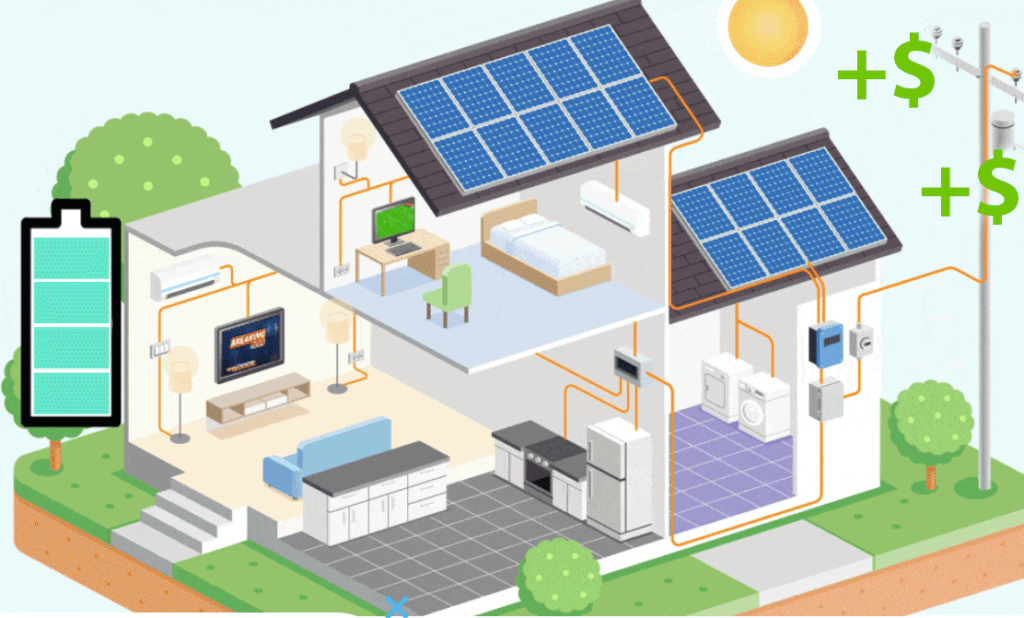
Calculating your solar microgrid’s energy bills savings
When your solar microgrid starts producing electricity, you’ll likely start saving money on energy bills.
Once those savings add up to more than the price of buying and upkeeping your solar microgrid, the microgrid has paid for itself and begins paying you.
Typically, a home’s or business’ solar microgrid takes at least a few years to pay for itself. That payback period may be even shorter if you use little electricity or live where energy is expensive.
Payback period = solar microgrid price / annual savings on energy bills
Once you know the payback period, compare it to the length of the solar microgrid’s warranty(s) to see if it is guaranteed to pay for itself.
Guaranteed savings = payback period > length of the warranty
That’s how to calculate if you’ll save money by getting a solar microgrid.
Need help assessing (1) your solar microgrid’s price, (2) how much it’ll save you annually, and (3) the length of its warranty? Then follow these 7 steps:
The 7 steps to calculate if you’ll be saving money by getting a solar microgrid:
- Add up how much you spend on energy in a year
- Determine how much electricity you use in a day
- Look up how many hours of sun your home gets
- Decide what size solar microgrid you need
- Calculate the solar microgrid price by size
- Calculate the solar microgrid’s payback period
- Compare the payback period to the length of the warranty
1. How much do you spend on energy bills today?

To determine if you’ll save money on energy bills with a solar microgrid, you first need to know how much it currently costs to power your household.
If you buy energy from a utility company, look at your bill and find a breakout of the energy prices they charge and how much you spend on gas and electricity.
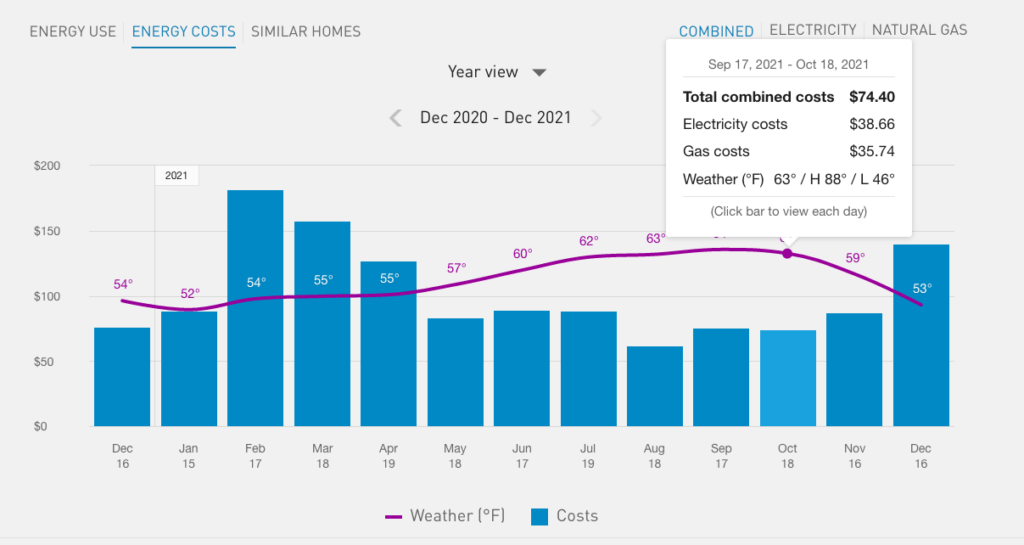
If your home is already fully electric or you plan to upgrade all your appliances to electric once you have a solar microgrid, then look at the bill’s total amount.
If you’re still going to use some gas to power your home even after having a solar microgrid, then just look at what you’ve been spending on electricity.

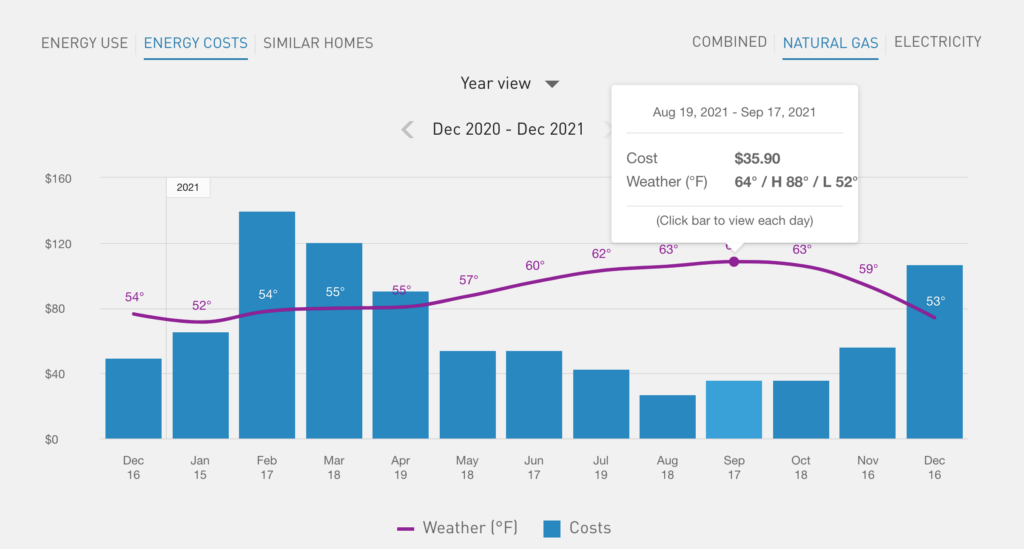
Living off-grid or getting energy in addition to what you buy from a utility company? Then you add up the cost of buying wood, charcoal, kerosene, gas, diesel, and electricity.
Once you have the total annual cost of the energy you’re planning to offset with the solar microgrid, you’re ready for Step 2.
$1,950 = Annual electric bill *Average household in Hawaii
2. How much electricity do you use every day?
You need to know how much electricity you use annually to determine if a solar microgrid will collect enough energy to meet your daily needs.
Calculating your energy consumption (in kilowatt-hours kWh) over the past 12 months ensures you get a solar microgrid that’s powerful enough to meet your needs year-round. Our energy needs vary daily and seasonally due to weather, hosting guests, vacations, new appliances, etc.
If you have a utility company, they have a breakdown of your monthly consumption.
If you live off-grid, manually calculate how much you spend on energy each year.
Once again, if you’re still going to use some gas or other fuel to power your home after getting a solar microgrid, then just look at what you’ve been spending on electricity.
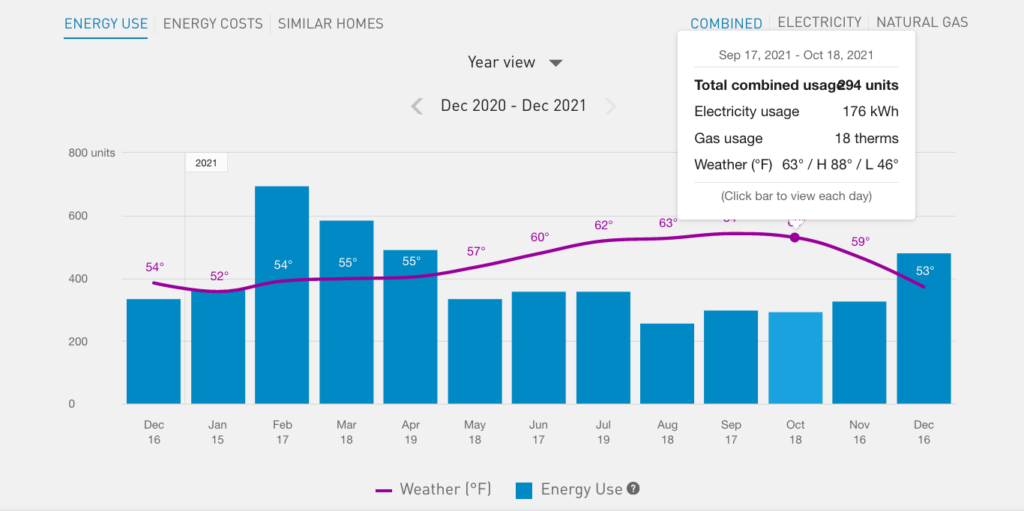
For a more accurate estimate of your usage, take the annual average for the past couple of years. *This assumes you haven’t had major changes in lifestyle/energy use during that period. If you have, then just use the 12-month period(s) that best reflect your usage going forward.
Once you have your annual electricity usage, divide it by the number of days in the year to estimate your daily consumption, then you’re ready for Step 3.
6,444 kWh = Annual electricity usage *Average household in Hawaii
17.65 kWH = 6,444 / 365 = Daily electricity usage *Average household in Hawaii
3. How much sunlight does your home get?
How much sunlight your solar panels can soak up plays a significant role in determining if a solar microgrid will generate enough electricity to meet your needs. It also determines if saving money on energy bills is possible with a solar microgrid or if another type of renewable microgrid is a better option.
Look up the annual average of peak sunlight hours you receive each day.
The National Renewable Energy Laboratory mapped most of North and South America’s annual average daily hours of peak sunlight.
Once you have the number of peak sunlight hours your home receives in a day, then you’re ready for Step 4.
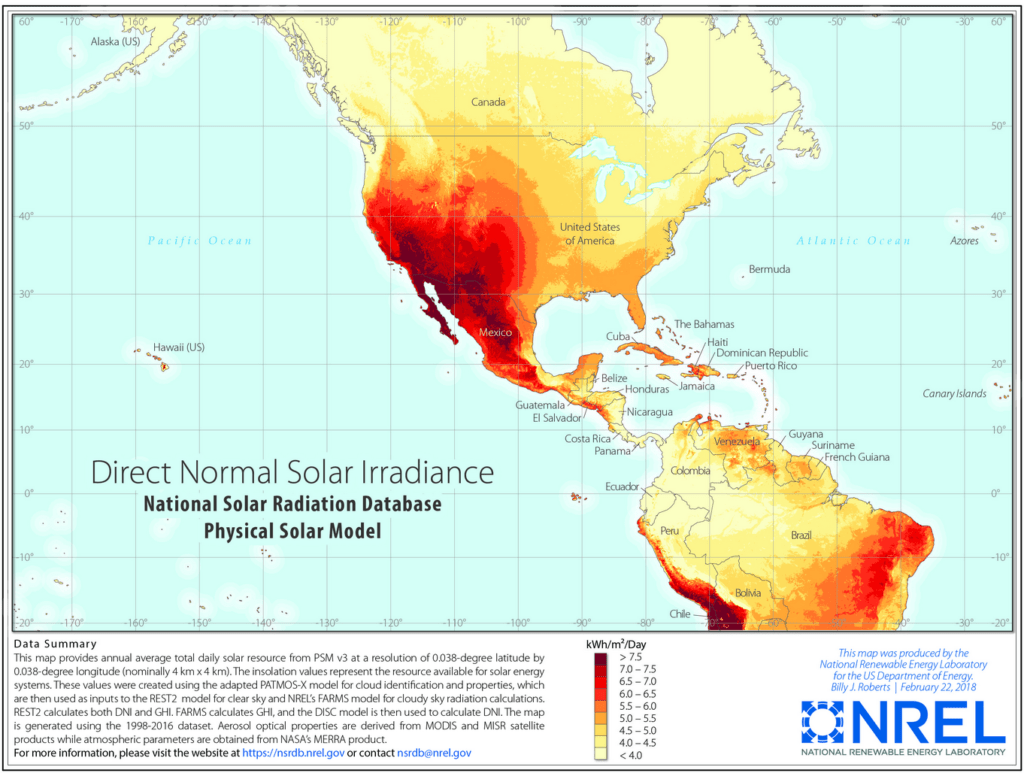
6 hours = Daily peak sunlight *State of Hawaii
4. How much electricity can solar microgrids produce where you live?
Now let’s figure out how much energy your solar microgrid needs to collect and store to offset your current annual usage. That way, you know if a solar microgrid works as your household’s primary energy source and if you’ll save money on energy bills.
We measure solar panels’ power output in kilowatts (kW).
We measure batteries’ energy storage capacity in kilowatt-hours (kWh) – the same metric we’ll use to measure our energy use.
How big a solar system do you need?
It’s a simple formula to determine the solar system size needed to cover your annual electricity usage.
1. Take the average daily kWh of electricity you use, and divide it by the average daily hours of peak sunlight you receive.
2.95 kW = 17.7 kWh / 6 hours
2. Divide the result by 80% to account for the electricity lost when converted from the direct current (DC) solar panels produce to the alternating current (AC) your home uses.
3.7 kW = 2.95 kW / 80%
3.7 kW = Solar system size needed to cover annual electricity usage. *Average household in Hawaii
You want a solar system that’s a bit larger than what the calculation says. That way, you won’t worry about producing enough power when the weather is terrible or you just want some extra juice.
So for our ‘average household in Hawaii’ example, I’d get a solar system of around 4 kW.
How much battery storage do you need?
The average kWh you use daily is the energy storage capacity needed to fully power your household for 24 hours.
17.7 kWh = Battery capacity needed to provide 24 hours of elecricity usage. *Average household in Hawaii
During the day, your microgrid’s solar panels will recharge the battery and power your home. So, you likely don’t need a battery that can power your household for 24 hours. Although, having one that size will give you plenty of extra battery storage and the ability to sell more electricity and storage space.
For most people, a battery that stores 12 hours’ worth of energy is enough to ensure you don’t run out of power.
8.9 kWh = Battery capacity needed to provide 12 hours of elecricity usage. *Average household in Hawaii
As with the solar system, you likely want batteries with enough capacity to provide backup power for more than just the average day.
When calculating the size and price of your battery, you need to decide how many kWh of stored energy match your lifestyle, resiliency, and financial goals.
Once you know how the size of the solar system and battery you want, then you’re ready for Step 5.
5. What’s the total price of your solar microgrid?
Add your payments for components, services, and installation
To calculate if you’re saving money on monthly energy bills and the solar microgrid’s overall return on investment (ROI), first add up what you’re paying for the microgrid’s solar panels, battery, installation, and services.
The 3 factors most closely tied to solar microgrid prices are:
- Where you live
- The quality of its components
- The amount of energy it collects and stores
In the U.S., EnergySage, Solar Reviews, and Clean Energy Reviews share the average prices for buying and installing home solar systems and batteries. Their websites also enable you to request competing quotes from local solar microgrid providers.
$11,640 = 4 kW solar system *Average price in Hawaii
$5,940 = 9 kWhs of lithium-ion battery storage *Average price in the Hawaii
$17,580 = $11,640 + $5,940 *The price of a solar microgrid that produces enough electricity to power the average household in Hawaii for 24 hours and stores enough energy for 12 hours of usage.
Remember that having someone install or interconnect your solar microgrid may incur additional costs.
Also, many solar microgrids companies offer free monitoring software that tracks electricity production, usage, and storage. But if you purchase the solar system and batteries from different companies or install them on your own, then you may need to buy separate monitoring software.
Talk to the professionals who sell and install solar systems, batteries, and solar microgrids in your area to assess the additional costs. It’s likely worth speaking to a couple of companies to compare their prices and service levels.
Subtract the value of available incentives
Apply the value of available incentives to the total price of the solar microgrid’s components, installation, and services.
Tax breaks, tax credits, rebates, and discounts are frequently available from governments and non-profits that want to promote resiliency and sustainability.
In the US, you can apply the Federal Investment Tax Credit to the total price of solar panels, batteries, and installation.
$13,009 = $17,580 x 74% *The price of the average household in Hawaii's solar microgrid after applying the 26% Federal Investment Tax Credit.
Once you’ve calculated the solar microgrid’s price and subtracted the incentives’ value, you’ll know how much is needed to buy it, then you’re ready for Step 6.
6. How quickly will your solar microgrid pay for itself?
Now the moment of truth…how quickly will you start saving money by switching to a solar microgrid?
As we discussed, it’s likely as soon as your solar microgrid starts producing electricity. But we want to know if our investment in a solar microgrid will pay for itself, paying you back for your initial investment in the equipment and installation and then paying you extra moving forward.
So we need to calculate how quickly your savings on energy bills equals the price of the solar microgrid = the payback period.
If the solar microgrid fully offsets your current electricity usage, your current annual electricity costs become your savings.
6.7 years = $13,009 / $1,951 per year *Payback period for a solar microgrid that produces enough electricity to power the average household in Hawaii for 24 hours and stores enough energy for 12 hours of usage.
After your savings on energy bills equal the price of the solar microgrid, the solar microgrid starts paying you.
Once you know your payback period, you’re ready for Step 7. Our final step!
7. How long is your warranty?
Knowing how long it takes for the solar microgrid to pay for itself could be the last step in deciding if you will save money on energy bills. But we want to see if it’ll pay for itself with the money saved on energy bills while it’s still under warranty. If it does, then your solar microgrid has a fantastic ROI and you’re guaranteed to pay yourself back for the initial investment in the equipment.
So the final step is comparing the length of the solar microgrid’s payback period with the component of the solar microgrid with the shortest warranty.
High-quality solar panels have 20-25 year warranties, although some solar panels’ warranties are as short as 5 years. Well-made lithium-ion batteries, with at least 1 kW of storage capacity, typically come with a 10-year warranty.
3.3 years = 10-year battery warranty - 6.7 years *The minimum time that the average household in Hawaii will get free electricity from their solar microgrid. An amazing return on investment!
$643.5 = (3.3 years x $1,950)/10 years *Annual savings on energy bills for average household in Hawaii after switching to getting their electricty from a solar microgrid.
Saving money on energy bills? Consider this…
For over a decade, the solar industry has measured its customers’ payback period and ROI by comparing the price of the solar purchase or lease to the savings on energy bills. That’s essentially the same thing we do here with a solar microgrid.
Unsurprisingly, Hawaii’s solar microgrids have the quickest payback of all 50 states (see chart below). Hawaii has the most expensive grid electricity.
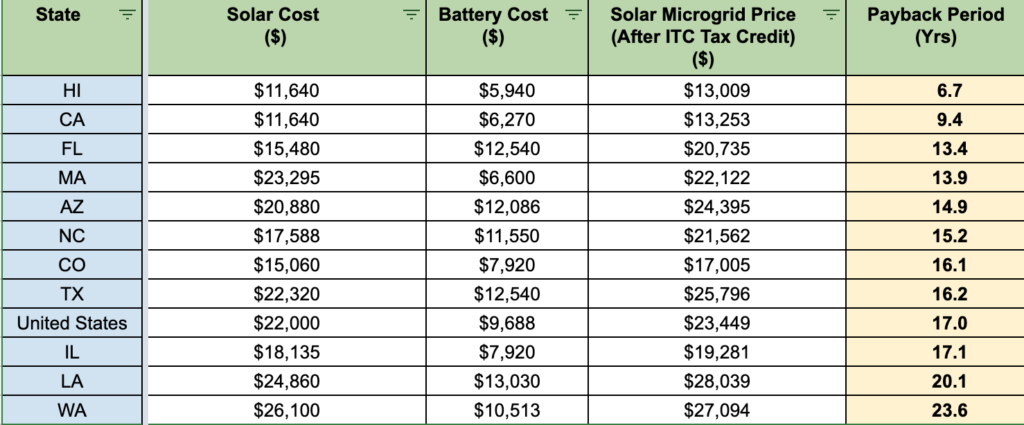
It also isn’t surprising that the average U.S. household’s payback period is longer than 10 years. Lithium-ion home battery prices keep falling, but they only became cost-effective for some homeowners in the past 2 years.
As previously noted, solar microgrids tend to pay for themselves quickly if you don’t use much energy, especially if most of the household’s power comes from burning charcoal, firewood, or kerosene.
Regardless of how much energy we use today, most of us desire to sustainably use and afford more power…not less. Here are a few tips for increasing how much money a solar microgrid saves and makes you.
Tips for saving more money with a solar microgrid

Lower the price of the battery
Lithium-ion batteries account for a big part of a solar microgrid’s price. Using a battery with less energy storage capacity or with lead-acid instead of lithium-ion chemistry can drastically reduce costs.
Your home can stay powered for the same amount of time with a smaller, and therefore less expensive, solar microgrid and battery if you’re willing to run fewer appliances on it. Considering what’s critical vs. ideal to keep powered during a grid blackout or when the sun isn’t out, you may realize you can reduce the battery size.
Ultimately, the battery size that’s the right fit for you depends on how much backup power you need to achieve peace of mind.
Lithium-ion batteries have become very popular in solar microgrids because they’re longer-lasting, lighter, and store more energy than lead-acid batteries. However, lead-acid batteries are much less expensive.
Many renewable microgrids use lead-acid batteries for energy storage. Lead-acid can be a great option if you have lots of space to store batteries and a tighter budget.
Install the solar microgrid yourself
A solar microgrid is like most things. You’ll save money if you install everything yourself, as long as you do it correctly and efficiently. Your effort and time can turn into savings of 30-50% on the price of the solar microgrid.
Many people have done it. But don’t be fooled. It’s hard work.
If you install the solar microgrid, it’s crucial to your safety to have an experienced electrician review your work before you start generating power.
Factor in the cost of a power outage
We didn’t factor it into our calculation, but there’s financial value in never experiencing a power outage. The impact of avoiding a blackout is different for each of us.
How much is it worth to you to never again experience spoiled food, lost business, or health risks from not having electricity?
Buy a solar microgrid when the price comes down
Still can’t figure out a way to make the finances work today? Just keep these energy price trends in mind…
- Every year, the prices of solar panels and batteries come down.
- Every year in the U.S., the cost of electricity from the grid goes up about 2%.
For those two reasons, in almost every state, solar microgrids are paying for themselves quicker in 2022 than in 2021.
Make money with your solar microgrid
Arbitrage energy prices from your utility company
Depending on your utility company, their energy prices often change as frequently as every hour, minute, or even by second.
We can equip solar microgrids with software that takes advantage of these price changes, automatically allowing you to switch to the lowest-cost electricity source.
With the software set up, the solar microgrid sells your excess electricity when prices on the grid are highest, then switches you to grid electricity when prices are low.
Join your local virtual power plant
Becoming a virtual power plant (VPP) member networks your solar microgrid with other microgrids, pooling excess electricity production and energy storage. The VPP monitors its members’ available resources and sells them to utility companies so the grid can use them. In doing so, you can make hundreds to thousands of dollars annually and shorten your solar microgrid’s payback period.
Calculating precisely how much money you’ll save on energy bills.

The methodology outlined above is an excellent way to estimate your payback period and savings on energy bills. But, to get a precise calculation, you also need to consider these factors:
- How much solar power generation and storage do you need?
- How much sunlight reaches the panels’ exact location annually?
- What are the solar panels’: model, degradation rate, and warranty length?
- What are the battery’s: model, degradation rate, and warranty length?
- How is the solar microgrid going to be installed?
- How is the solar microgrid going to be interconnected?
You can calculate the exact payback period by determining these factors on your own, but it’ll likely be easier to consult a solar microgrid provider. Reputable solar microgrid providers offer free consultations where they calculate these factors and then provide a microgrid design and price quote.
Energy Sage allows you to request and compare competing quotes from national and local microgrid installers in North America.
More resources for saving money on energy bills
Savings money on energy bills is a popular Electric Islands theme, and there are even more techniques and technologies you can use.
To learn about more money-making and saving opportunities, check out these blog posts…

